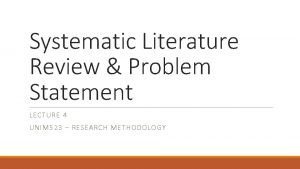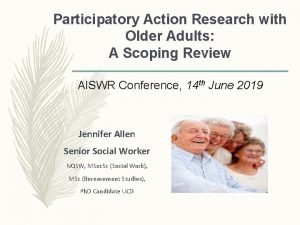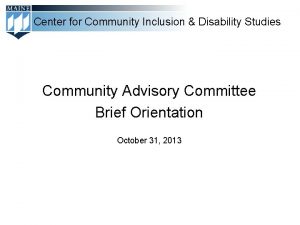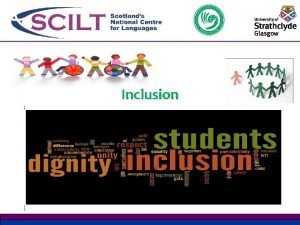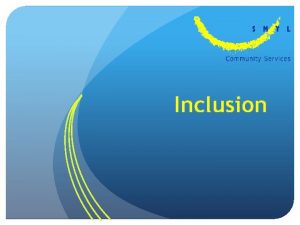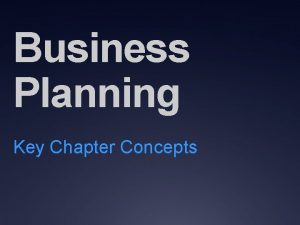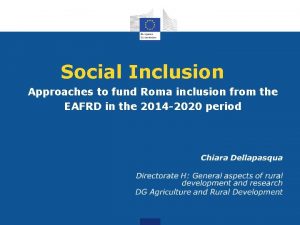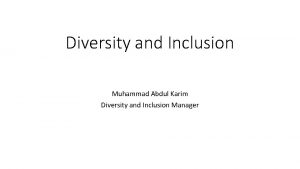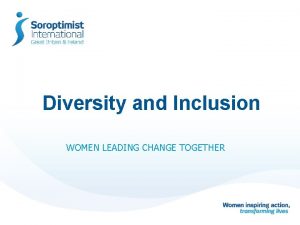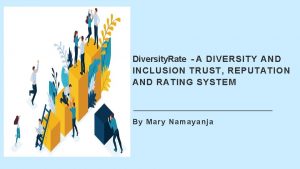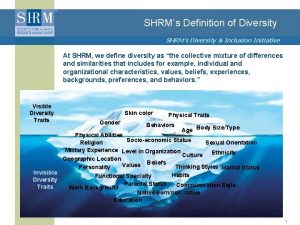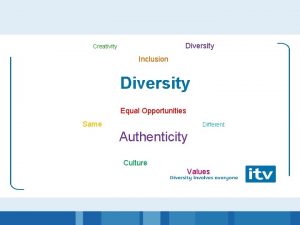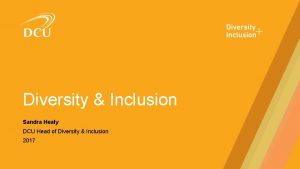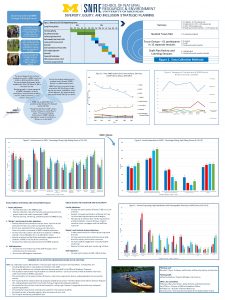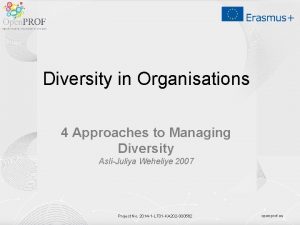Key Concepts of Inclusion and Diversity Planning approaches






























- Slides: 30

Key Concepts of Inclusion and Diversity Planning approaches to inclusion 1 Julian Brown

Session Overview • Understand how specific indicators could be used as self-evaluation tools when examining inclusion in schools • Critically evaluate approaches at school level towards developing inclusive policies, cultures and practices

Perspectives of Inclusion • 'Inclusion is about the quality of children's experience; how they are helped to learn, achieve and participate fully in the life of the school‘ (Df. ES, 2004) • ‘Inclusion is a sense of belonging, of feeling respected and being valued for who you are’ (Miller and Katz, 2000) • ‘…. a process of increasing the participation of pupils in, and reducing their exclusion from, the cultures, curricula and communities of their local school. ’ (Ainscow, 1999)

Perspectives of Inclusion View of a headteacher from a Thailand school: ‘We looked at many different schools and theories and realised that a child-centred approach – that is one where we encourage children to think for themselves and solve problems together – was one which might work for us in our school. Looking back now, I feel that we took some of the more positive things from western education and incorporated them into Thai culture. It was very important that we maintain our Thai identity and we can see this in our Buddhist approach to spirituality – head, hand, heart – which underpins everything that happens in the school. ’ (Grimes, 2013)

Schools and Inclusion is an issue for all staff rather than the exclusive responsibility of a particular group or individual in a school. Inclusion is social as well as educational. Inclusion is an on-going process, not a fixed state.

Salamanca Framework: priorities for schools and settings Attitudes Skills Curriculum Environment Policies

Using Indicators for Inclusion http: //www. inclusionmark. co. uk/

es tic ac pr In c lu si v ep oli c ie s Lessons respond to student diversity; resources are identified to support learning and participation e siv clu In Every policy minimises exclusionary pressures; involves pupils, parents and staff Inclusive cultures Indicators – pages 3941, 50 Shared values; collaborative decision-making; everyone is valued; continuous process (Booth and Ainscow, 2002, p. 7)

Inclusive Practices The environment Involving the family Involving the pupil Approaches to teaching and learning Collaboration across staff

Key Questions to Consider Family Do families feel they are involved in the community? Are some parents more involved than others? Why is this? Are some groups under represented? Are some families hard to reach? What have we tried to engage with families? Pupil Staff collaboration The environment Approaches to teaching and learning

The Environment • Arrange physical space and equipment to facilitate learning • Control temperature, humidity and ventilation • Control lighting • Provide optimal acoustics • Increasing good sounds/reducing bad sounds • Set up classroom environments that are attractive, stimulating and safe – Mitchell, 2014, pp. 224 -228 Did you know? In Sweden a study reduced absenteeism from 8. 31% to 3. 75% by introducing electrostatic air cleaning technology Did you know? In a 1999 study in the US, involving 21, 000 students, test scores in reading and mathematics improved where students had the most classroom daylight. Did you know? In a study of 142 London primary schools authors found that 65% of the schools were exposed to noise levels in excess of WHO standards and there was a significant negative relationship between noise levels and nationally standardised tests.

Staff Collaboration • Questions for reflection: – What are the different roles in schools and settings beyond those of a ‘teacher’ or ‘lecturer’? – What is the purpose of those roles? – What makes for effective collaboration with professionals in school and those out of school? Enabling factors Disabling factors

Staff Collaboration Teaching Assistants: Impact on Academic Progress ‘Results on the impact of TAs on pupils’ academic progress were clear, but surprising. It was found that pupils who received the most support from TAs made less progress in core subjects over a school year than similar pupils who received less support from TAs, even when controlling for characteristics that can affect progress and the allocation of TA support, such as prior pupil attainment and level of SEN. The results were startling, but we argue that it is not individual TAs who are at fault, but systemic, structural factors within which TAs operate and over which they have little or no control. ’ (Blatchford et al, 2012, p. 6) https: //educationendowmentfoundation. org. uk/evidencesummaries/teaching-learning-toolkit/teaching-assistants/

Staff Collaboration Deployment Considerations • ‘Where properly trained and supported, TAs can have a positive impact on primary aged pupils’ academic progress’ • However, ‘by simply increasing the numbers of TAs in a school, the attainments of all pupils will not necessarily improve’ • Therefore, ‘TAs should only be appointed if they have a specific set of tasks to perform with an identified child or small group of children and they are provided with sufficient training, support and monitoring at all times. ’ (Farrell et al, 2010)

Staff Collaboration EDTA Report (2012) Preparedness Deployment Practice ‘In terms of preparedness, schools found that creating time for teachers and TAs to meet had a positive effect. Primary schools created liaison time by changing TAs’ hours of work, though this was still a challenge for secondary schools’ SLT thought more strategically about the purpose of the TA role and expectations in terms of pupil outcomes. Many conducted some form of audit of current practices to establish the need for, and the extent of, change required. Overall, attention had been turned to how TAs could ‘add value’ to the teacher’s role rather than replace it. TAs were encouraged to adopt the pedagogical goal that interactions with pupils should be about understanding, not task completion … questioning frameworks to help pupils remain in charge of and responsible for their own learning; and secondly, strategies to help pupils become independent learners.

Why should I involve the pupil/student? How do I involve him/her? Education, Health and Care Plans may include: One Page profiles Relationship circles Good day/Bad day Important to/important for What's working/not working Further info: Helen Sanderson Associates Courtesy of Gwyn Botterill – EHC Service Manager - Northamptonshire

One Page Profile What do people appreciate about me? What is important to me?

Involving the pupil • Pupils value: • Teachers said: ü being respected and treated seriously – Pupils are aware of their own learning needs more if they discuss them ü knowing their views are having an impact – Pupils are more confident to share if they don’t understand something ü having greater control – Pupils have a greater sense of why they are doing a particular task and have a stronger sense of ownership ü being able to talk about learning ü feeling more positive about learning – Pupils are more ready to become involved and to take initiatives Consulting Pupils about Teaching and Learning 2000 -2003 (ERSC and TLRP) http: //www. tandfonline. com/doi/abs/10. 1080/02671520903330992

Do pupils have a voice? As the 2011 Report of the Secretary-General on the Status of the Convention on the Rights of the Child noted, “It remains difficult for children with disabilities to have their voices heard. Initiatives such as school councils and children’s parliaments, consultative processes to elicit children’s views, as well as judicial proceedings, commonly fail to ensure the inclusion of children with disabilities, or acknowledge their capacities for participation. ” What methods are used to seek the views of individual pupils? Groups Individual Are any groups over or under represented? Whole school What involvement do pupils have on wholeschool processes and decisions?

Involving families Model from Hornby (2010) http: //www. youtube. com/watch? v=q. Nh. L 9 Zl. MPCE Parental Contributions Some All Parental Needs Policy Communication Resource Liaison Collaboration Education Information Support All Some

Inclusive Policies: a Case Study from the Netherlands Parents of children with disabilities: a) Prefer mainstream education – social and academic reasons b) Concerned about the skill levels of teachers Parents of children without disabilities: a)Mixed feelings – concerns about the impact on the other children Overall findings: Overall positive about inclusion, however: a) Lower scores on the ‘preparedness of general school teachers’, especially for severe needs b) Mothers more positive than fathers c) Parents 25 -35 more positive than 36 -45 d) More positive about motor disabilities than intellectual and severe or behavioural (Parents/teachers/children may be ‘frightened’) De Boer, A. and Munde, V. (2015) Parental Attitudes Toward the Inclusion of Children with Profound Intellectual and Multiple Disabilities in General Primary Education in the Netherlands, The Journal of Special Education. 49 (3), 179 -187.

Approaches to teaching and learning Setting, streaming and target grouping What are the methods of differentiation? What is the justification for this approach? Differentiation within mixed ability teaching https: //educationendowmentfoundation. org. uk/resources/teaching-learning-toolkit/setting-or-streaming/ What is the justification for this approach? What does the evidence suggest?

Approaches to differentiation § content (pupils work on various aspects of the same subject matter) § interest (activities reflect pupils’ own interests/experiences) § pace (pupils work through material at varying paces) § sequence (pupils work at materials in varying orders) § level (pupils work on similar concepts at different levels) § access (materials are presented in different modes) § response (pupils respond to similar activities in varying ways) § structure (work presented in small developmental steps) § teacher time ( 1: 1 with teacher) § teaching style (range of discursive, investigative, didactic styles) § learning style (problem solving, creative, etc) § grouping (whole class, groups, pairs, individual)

Universal Design for Learning(UDL) “The design of instructional materials and activities that allows the learning goals to be achievable by individuals with wide differences in their abilities to see hear, speak, move, read, write, understand English, attend, organise, engage, and remember. It is achieved by means of flexible curricular materials and activities that provide alternatives for students with disparities in abilities and background as well as those with no visible disabilities. (It) applies not only to the content, but also to goals, methods and manner of assessment. ” http: //www. cast. org/our-work/about-udl. html#. WDRCKH 3 W 8 Xs cited by Mitchell, 2014, p. 238

School Readiness for Inclusion Indicator First steps Some Many evidence of examples this Evident throughout the school Staff attitudes Staff skills Community inclusion Leadership and vision Procedures and structures Environment and resources (adapted from Hallinger and Lee, 2011)

Quality Assurance of Inclusive Teaching Of. STED 2010 Pupils with SEN looked to the teacher for their main teaching and to support staff for support Assessment was secure, continuous and acted on. Teachers planned opportunities for pupils with SEN to collaborate, work things out for themselves and apply what they had learned in different learning situations Teachers’ subject knowledge was good, as was their understanding of pupils’ needs and how to help them. Lesson structures were clear and familiar but allowed for adaptation and flexibility. All aspects of a lesson were well thought out and any adaptations needed were made without fuss to ensure that everyone in class had access. Teachers presented information in different ways to ensure all pupils with SEN understood. Teachers adjusted the pace of the lesson to reflect how children and young people were learning. The staff understood clearly the difference between ensuring that children and young people were learning and keeping them occupied. Respect for individuals was reflected in high expectations for their achievement. The effectiveness of specific types of support was understood and the right support was put in place at the right time.




References • Blatchford, P. , Webster, R. and Russell, A. (2012) Challenging the Role and Deployment of Teaching Assistants in Mainstream Schools: the Impact on Schools. Institute of Education London: Esmee Fairbairn Foundation • Farrell, P. et al. (2010) The impact of teaching assistants on improving pupils’ academic achievement in mainstream schools: a review of the literature. Educational Review. 63 (4), 435 -448. • Hornby, G. (2010) Supporting Parents and Families in the Development of Inclusive Practice. In: Rose, R. (ed. ) Confronting Obstacles to Inclusion. London: David Fulton. pp. 75 -87. • Hornby, G. and Lafaele, R. (2011) Barriers to parental involvement in education: an explanatory model, Educational Review, 63, 1, 37 -52. • Mac. Beath, Demetriou, Rudduck and Myers (2003) Consulting Pupils : A Toolkit for Teachers. Cambridge: Pearson Publishing. • Mitchell, D. (2014) What Really Works in Special and Inclusive Education: using evidence-based teaching strategies. London: Taylor and Francis.
 Diversity, equity and inclusion 101
Diversity, equity and inclusion 101 Diversity and inclusion scorecard
Diversity and inclusion scorecard Centre for gender diversity and inclusion statistics
Centre for gender diversity and inclusion statistics Diversity and inclusion consulting
Diversity and inclusion consulting Centre for gender diversity and inclusion statistics
Centre for gender diversity and inclusion statistics Korn ferry d&i maturity model
Korn ferry d&i maturity model Diversity and inclusion training objectives
Diversity and inclusion training objectives Dei pulse
Dei pulse Hse diversity equality and inclusion strategy
Hse diversity equality and inclusion strategy Mona talent priority
Mona talent priority Champion equality diversity and inclusion
Champion equality diversity and inclusion Pta diversity and inclusion
Pta diversity and inclusion Key concepts of diversity
Key concepts of diversity A company's resources and capabilities represent
A company's resources and capabilities represent What is ecosystem biodiversity
What is ecosystem biodiversity Genetic diversity vs species diversity
Genetic diversity vs species diversity Boosterism approach to tourism planning
Boosterism approach to tourism planning Educational planning approaches
Educational planning approaches Business model sample
Business model sample Key partners
Key partners Importance of langue and parole
Importance of langue and parole Promotional concepts and strategies
Promotional concepts and strategies Reviewing key concepts: flatworms, annelids, and roundworms
Reviewing key concepts: flatworms, annelids, and roundworms![] ]](data:image/svg+xml,%3Csvg%20xmlns=%22http://www.w3.org/2000/svg%22%20viewBox=%220%200%20200%20200%22%3E%3C/svg%3E) ]
] Example of statement of the problem
Example of statement of the problem Search strategy example
Search strategy example What is the inclusion and exclusion criteria in research
What is the inclusion and exclusion criteria in research California map to inclusion and belonging
California map to inclusion and belonging Brighton and hove inclusion support service
Brighton and hove inclusion support service Center for community inclusion and disability studies
Center for community inclusion and disability studies Etsu equity and inclusion conference
Etsu equity and inclusion conference
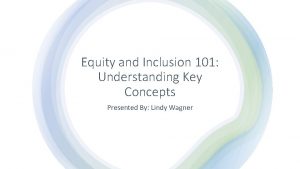

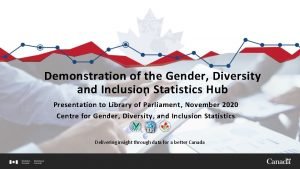

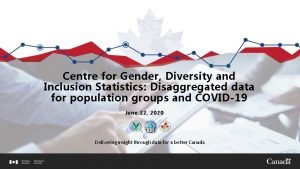
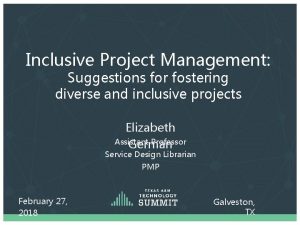




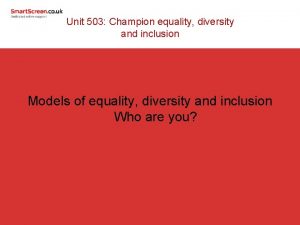
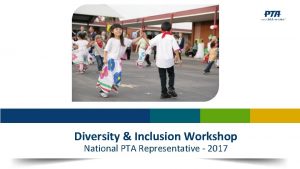
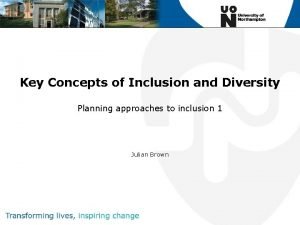
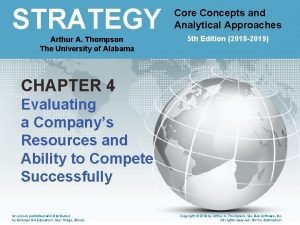



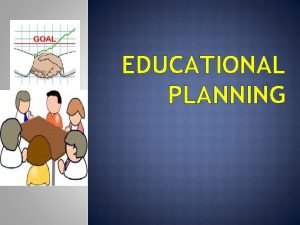





![] ]](https://slidetodoc.com/wp-content/uploads/2020/11/2404819_9eb8166b01395994bc3f851e1b2a9913-300x225.jpg)
